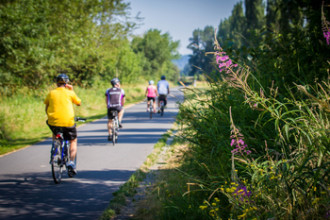
A 12-foot trail is only a 12-foot trail so long as the whole thing is clear.
One great part of our major regional trail network is how close you get to the woods and greenery as you bike between major urban centers. But often, that greenery gets a little too close. And when branches, vines and blackberry starts extending into the trail’s path, the effective width of the trail shrinks.
The good news is that King County is going to start cutting it all back starting Tuesday. The bad new is that you may encounter delays on the trail for the next two or three weeks as crews work.
Details from King County:
Annual vegetation maintenance alongside King County Parks’ Burke Gilman and Sammamish River trails will require several weeks of “rolling closures” with delays of up to 15 minutes for trail users as crews perform the work.
Beginning Tuesday, May 26 at approximately 7:30 a.m., crews using tractor mowers will start clearing vegetation along the Burke Gilman Trail at the Seattle-Lake Forest Park boundary near Northeast 145th Street.
Working Monday through Thursday from 7:30 a.m. to 3 p.m., crews will continue their work until reaching King County’s Marymoor Park in Redmond. The clearing is expected to be completed by June 19.
Trail traffic will be controlled by flaggers in both directions through the active work area to ensure safety while the work is underway.
The mower will be operated in 15-minute intervals, then driven off the trail and shut down to allow traffic to pass, before resuming for another 15-minute stretch of work.
Clearing vegetation from the trails’ shoulders and ditches helps keep these popular routes safe for the public by maintaining open sightlines and improving drainage.








Comments
9 responses to “King County will clear overgrowth from Burke-Gilman/Sammamish River Trails, be prepared for delays”
so it sounds like they won’t be doing any clearing south of 145th? So those blind intersections in the Fremont/Ballard areas will remain completely obscured?
That is the responsibility of the Seattle Dept. of Transportation. King County manages the Burke north of the city line. This is why the trail quality is so different once you cross 145th. I always joke with my riding buddy that once you hit the thud-thud-thud of tree roots on the trail, you know you’re back in Seattle.
I think you mean the Seattle Parks Dept? Which is now flush with cash (I may be exaggerating), so it might be worthwhile to ask them to put more money into trail maintenance. Or is it just Friends Of The Burke who do brush clearing?
I give a tip of the hat to King County and Redmond for doing a good job on the Sammamish River Trail and a wag of the finger to WSDOT for their upkeep on the 520 trail.
The former has regular mowing of the grass and repairs to bad pavement, while the 520 trail is overgrown with vegetation, pavement damaged by tree roots and almost no maintenance activity.
I think it’s Seattle Parks from 145th to the UW campus; I know UW owns and maintains the section through campus, and Quadrant owns the waterfront section in Fremont. I think the rest is SDOT.
Would be great to see the same on the Interurban Trail in south King County, if PSE has ever agreed to renew the County’s lease on the trail. (Expired interlocal agreement has been blocking Interurban improvements for years.)
FWIW, down in CA the city of Mountain View closes trails for days at a time for mowing. I guess they have more parallel alternatives for crossing 101 than we have for going from LFP to Woodinville, but the on-road ones alternate between door-zone sketchiness and interchange sketchiness. So I have to give King County credit for trying to minimize the disruption…
I do sort of question, in general, the use of large-scale equipment in human-scale places. During one of the few times I’ve been to an “old-world” city I saw some workers trying to use a backhoe to do some kind of work on a building on the edge of a public square. It was totally disruptive to that entrance to the square, and signs on nearby businesses complained (in a style of passive aggression familiar to us) of noise, vibration, and building strikes. Of course, the building under repair was too old to have been built with such machines! There are advantages to more modern methods of maintenance, but the regular practice of creation and maintenance in small spaces almost always enriches the public realm.
Where local cities maintain the Interurban, I don’t believe I’ve ever seen the trail closed for brush clearing — they run the tractor mower and brush hog down one side of the trail, I ride by on the other side. No signs, no flaggers. Unless you’re wearing really loud headphones you’ve got plenty of notice that you’re approaching a brush hog.
And if you have really loud headphones, you deserve what you get.